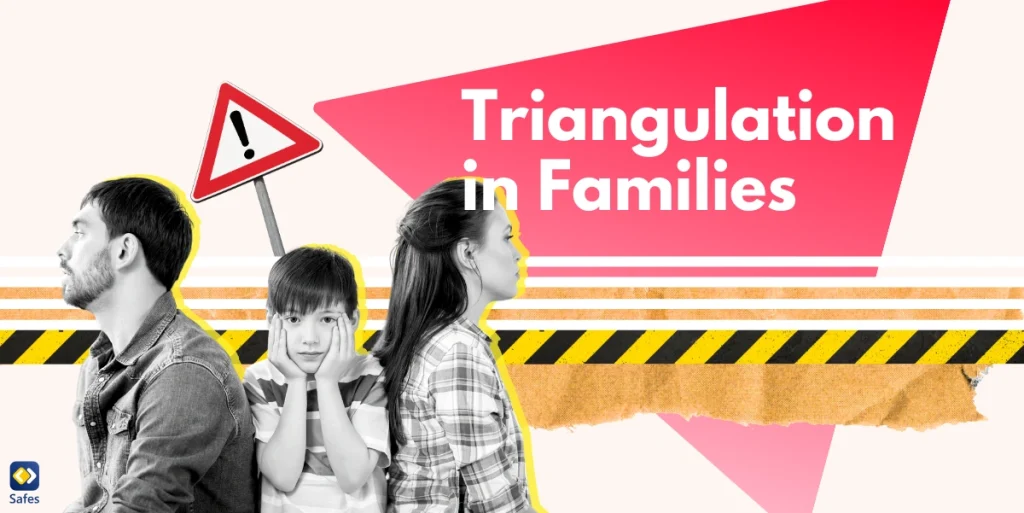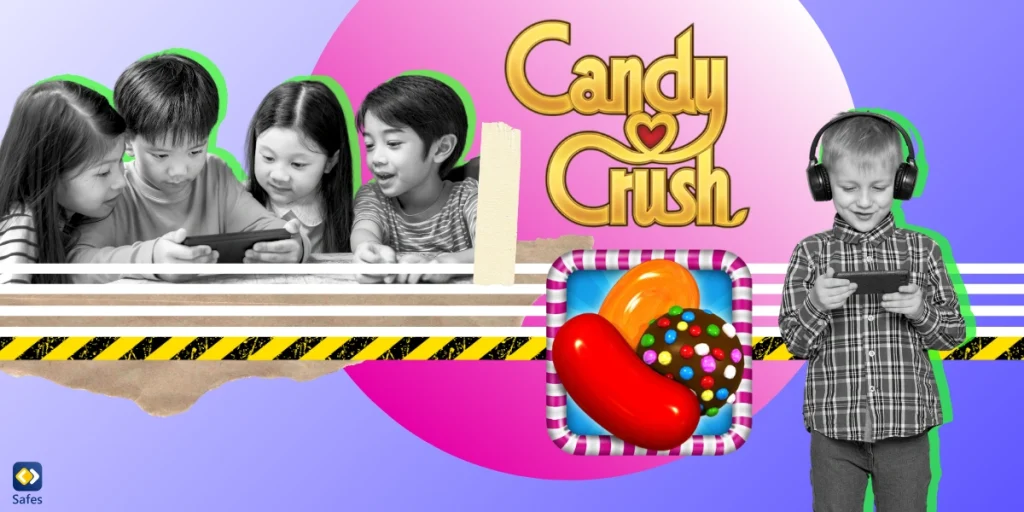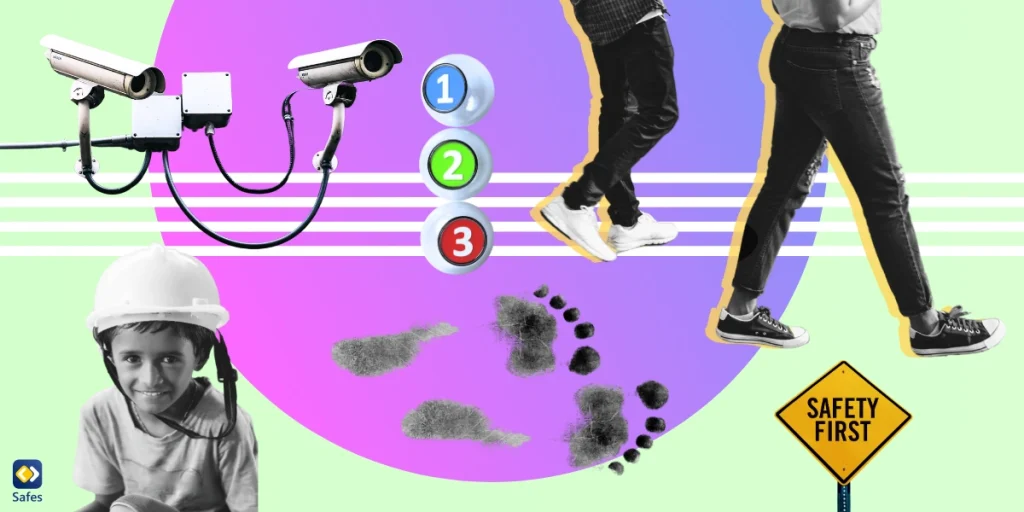Triangulation in families is a dysfunctional dynamic that can occur when one person incites conflict, tension, or an unwholesome partnership between two other individuals. Narcissistic adults or children who exhibit borderline personality disorder often use this deceptive strategy to evade accountability for their own emotions and actions.
Overall, triangulation involves indirect communication, emotional manipulation, and rivalry between family members. It’s essential to comprehend this dynamic and resolve it if you want to bring your family back into peace and encourage more genuine relationships. This article explores the concept of triangulation family dynamics, its impact on children, and how to identify and manage it effectively.
Triangulation’s Impact on Children
Triangulation can be very harmful, especially for children who get caught in the middle. When parents involve children in their conflicts, it can make the kids feel anxious, confused, guilty, and divided. This can lead to long-term problems like low self-esteem, attachment issues, and difficulties forming healthy relationships. Triangulation undermines a child’s sense of safety and trust within the family.
Both overbearing and overindulgent parents can create triangulation dynamics. Overbearing parents often try to control their children’s lives too much, causing resentment and tension. On the other hand, overindulgent parents may spoil their children, leading to manipulation and rivalry among siblings. Both parenting styles can distort healthy communication and contribute to triangulation.
Types of Triangulation
There are four common types of triangulation. Each type involves different dynamics and may require different approaches to address them. Here are the four types of triangulation:
Parental Triangulation
This occurs when parents involve their child in arguments or manipulative actions, putting the youngster under pressure to take sides or mediate between them. This might cause emotional discomfort and bewilderment for the children.
Sibling Triangulation
In this scenario, siblings manipulate their parents to gain favor or deflect attention away from their issues. This can create tension and competition between siblings and strain the parent-child relationship.
Narcissistic Triangulation
A narcissistic family member can create a toxic atmosphere by putting family members against one another to keep control and bolster their ego. This can lead to low self-esteem and bad relationships among family members.
Emotional Triangulation
This type of triangulation involves the indirect expression of feelings or worries through a third person. Instead of confronting problems openly, family members may express their emotions to another individual, leading to misunderstanding and unsolved conflicts.
Recognizing the type of triangulation present within a family is essential for addressing the issue effectively and fostering healthier communication and relationships.
What Are Some Family Triangulation Examples?
Triangulation in families can manifest in various ways, often resulting in strained relationships and emotional distress among family members. Let’s analyze how this dynamic unfolds in each provided scenario:
- A mother and father arguing about parenting decisions place the child in the middle, forcing them to choose sides: This situation forces the child to take on a mediator role, causing them anxiety and stress. The child may feel torn between their parents, which affects their mental health and relationships with both parents.
- A child who deliberately causes strife between their parents to divert attention away from their own problems: This scenario diverts attention away from the child’s issues and causes unnecessary tension between the parents. The parents may experience conflict and become more focused on resolving challenges with each other rather than addressing the child’s underlying concerns.
- A narcissistic parent who coerces their children to compete for attention and praise: This creates a toxic environment that promotes unhealthy competitiveness among siblings. This dynamic negatively impacts their self-esteem and relationships, as the narcissistic parent becomes the center of attention while the children constantly vie for approval.
- One family member intentionally leaves another family member out of important conversations, creating tension and resentment: This type of exclusion can lead to feelings of isolation and anger in the excluded family member, affecting their mental health and sense of belonging within the family unit.
- A child who puts their separated parents against each other to get what they want: The child takes advantage of the divorced parents’ position, intensifying any existing tensions between them. The child may feel torn and compelled to choose sides, affecting their relationships with both parents and perhaps having long-term emotional implications.
How Does Parental Triangulation Affect Children?
Triangulation in families can have significant negative effects on children’s emotional, psychological, and social development. Here are some ways in which parental triangulation can impact children:
Emotional Distress
Being caught in the middle of conflicts or manipulative dynamics can cause children to experience anxiety, stress, and fear. They may feel overwhelmed by the pressure to please everyone and maintain peace within the family.
Confusion and Guilt
Children may struggle to grasp the intricate dynamic of triangulation and feel terrible for failing to fulfill everyone’s expectations. This misunderstanding might cause self-doubt and difficulty in making decisions.
Eroded Self-Esteem
Triangulation often involves criticism, favoritism, or devaluation of the child’s thoughts and feelings. Over time, this can erode their self-esteem and self-worth, resulting in a lack of confidence in their talents and relationships.
Unhealthy Relationship Patterns
Children exposed to triangulation may develop unhealthy relationship patterns, such as codependency, weak boundaries, or manipulative behaviors. These habits can continue into adulthood, affecting relationships with friends, partners, and even their own children.
Difficulty in Emotional Regulation
Triangulation within families can deeply impact children’s emotional well-being. Children may struggle with controlling their emotions, resulting in emotional outbursts, withdrawal, or depression.
Some children may respond to tension and conflict by withdrawing emotionally, becoming less communicative and more isolated. This withdrawal serves as a defense mechanism, shielding them from the emotional turmoil they perceive around them.
The chronic stress and emotional burden of being caught in the middle of parental conflicts can lead to feelings of hopelessness and sadness, potentially resulting in depression. These feelings are exacerbated by the lack of a stable and supportive environment.
Withdrawal and depression can form a cycle. As children withdraw to protect themselves, they lose access to social support and positive interactions that could alleviate their stress. This isolation can intensify their feelings of sadness and hopelessness, reinforcing the depressive state. By understanding and addressing the impacts of triangulation, parents and caregivers can work towards creating a more secure and supportive environment for their children.

What Type of Person Uses Triangulation?
People who use triangulation often demonstrate personality traits or behaviors that lead to their reliance on this manipulative method. Individuals that participate in triangulation usually exhibit the following characteristics:
Narcissistic Tendencies
Narcissists may use triangulation in families to retain control and keep the spotlight on themselves. They usually crave admiration and have difficulty empathizing with others, making it easy to manipulate family members.
Poor Conflict Resolution Skills
People who fail to resolve issues directly may use triangulation to manage disagreements and avoid confrontation. They may assume that involving a third person is less threatening or intimidating than facing the issue head-on.
Insecurity or Low Self-Esteem
Individuals with low self-esteem use triangulation to gain reassurance and validation from others. By creating a situation where they feel needed or valued, they may temporarily alleviate feelings of insecurity.
Machiavellianism
People with Machiavellian tendencies tend to be manipulative and driven to achieve their objectives at all costs. They may use triangulation as a strategy to divide and conquer, exploiting family members to obtain power or control within the family dynamic.
How to Break the Cycle of Triangulation in Families
Breaking the cycle of triangulation in families requires honesty, self-awareness, and a commitment to healthier communication. Here are some steps that family members can take to address and prevent triangulation:
Recognize and Acknowledge the Problem
Recognizing that triangulation is happening is the first step toward resolving this issue. Openly address the problem with all parties involved, emphasizing the need for change.
Set Clear Boundaries
Set appropriate boundaries to keep family members from overstepping or manipulating others. This can include setting limits on the types of information shared, avoiding gossip, and refusing to take sides in conflicts.
Encourage Direct Communication
Foster an open, honest, and respectful conversation among family members. Encourage people to communicate their views and feelings directly to those involved, rather than relying on a third party.
Focus on Individual Relationships
Strengthening individual connections within the family can help to prevent the likelihood of triangulation in families. Try to spend meaningful time with each family member, building trust, understanding, and empathy.
Stay Neutral
When conflicts arise, try to remain neutral and avoid taking sides. This can help prevent feelings of resentment or tension from developing.
Seek Professional Help
If triangulation is a recurring problem in your family, consider seeking a therapist or counselor. They can offer guidance and support as you try to break the cycle of triangulation.

Is Triangulation a Form of Gaslighting?
While triangulation and gaslighting are both forms of manipulation, they are distinct methods that might occasionally overlap. Triangulation is basically the use of a third person to manage or control the dynamics of two people’s relationships. It often occurs within families or close social circles.
Gaslighting, on the other hand, is a type of manipulation that makes people question their own perceptions, memories, or sanity. It entails denying, minimizing, or misrepresenting facts to make the victim doubt their own reality.
In some cases, triangulation may include gaslighting tactics, such as denying specific occurrences or twisting information to confuse the individuals involved. Triangulation, on the other hand, can occur without gaslighting, and vice versa. It’s important to recognize the differences between these manipulation strategies to better understand and address them in interpersonal relationships.
Parental Triangulation in Separated & Divorced Families
In a study exploring the dynamics of familial relationships, researchers investigated the detrimental impact of the triangulation process on marital conflict and divorced couples. Triangulation represents a breach of the boundary between parental and child relational subsystems, significantly affecting children and adolescents who become significant third participants in parental conflicts. The research highlights the long-term consequences of triangulation exposure on children’s well-being, extending throughout their life cycle and into adulthood.
Through a comprehensive review of literature from various electronic databases, the study identified 58 relevant studies for analysis. Qualitative analysis focused on different types of triangulation observed in intergenerational family relationships, the impact of triangulation on children’s well-being and parent-child conflict, and effective intervention strategies.
Ultimately, the findings emphasize the importance of preventing the intergenerational transmission of marital conflict to mitigate the adverse effects of triangulation on children and families. By addressing these conflicting and destructive dynamics, there is potential to reduce mental health costs and improve the overall well-being of all individuals involved.
Meet Safes: The Best Solution for Keeping Your Children Safe Online
As digital parenting becomes increasingly complex, it’s essential for parents to understand and manage various forms of manipulation, including triangulation. Triangulation in digital parenting occurs when a child uses their devices or online interactions to create conflict or tension between family members. In such situations, a comprehensive parental control app like Safes can be an invaluable ally for parents.
Safes parental control app offers a wide range of features that empower parents to protect their children from digital threats and manage triangulation-related issues effectively. From monitoring screen time and blocking inappropriate content to tracking location and social media activity, Safes provides the tools needed to maintain a safe and healthy digital environment for your family.
Safes Features:
- Screen Time Management: Set limits on device usage to prevent excessive screen time.
- Location Tracking: Ensure your child’s safety and monitor their activities outside the home.
- Social Media Monitoring: Stay informed about your child’s online interactions and identify potential manipulative behavior.
Start your Free Trial of Safes today! Download Safes Family on your Android and iOS devices and take the first step toward effective digital parenting and managing triangulation.
Don’t let triangulation undermine your family’s digital well-being. To further enhance your digital parenting skills, check out our MacBook parental controls and experience the peace of mind that comes with knowing your child is safe online.
The End Note
Triangulation in families is a complicated topic that requires attention and knowledge. As previously noted, several types of triangulations can occur in family relations, including parent triangulation. In such instances, children frequently bear the brunt of the mental discomfort created by the ongoing conflict between their parents. Acknowledging and addressing parent triangulation allows families to improve communication, strengthen bonds, and create a more nurturing environment for their children’s growth.
By encouraging open communication, setting healthy boundaries, and promoting conflict resolution skills, families can mitigate the negative effects of triangulation. Finally, addressing children’s well-being and fostering a supportive family environment is critical for their emotional and psychological development, as well as the family’s general health.




